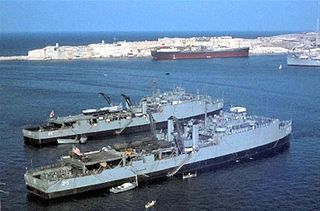
USS San Marcos (LSD-25) was a Casa Grande-class dock landing ship the United States Navy, named for the Castillo de San Marcos, the oldest masonry fort still standing in the United States. In 1911, the second-class battleship Texas had also briefly borne the name San Marcos, perhaps for the town of San Marcos, Texas. The ship served in the United States Navy from 1945 to 1970. In 1971, the vessel was loaned to the Spanish Navy as Galicia (TA31), before being outright transferred in 1974. In 1980, the vessel's pennant number was changed to L31. Galicia was taken out of service by the Spanish Navy in 1988 and was scrapped in 1989.

USS Tarawa (LHA-1), the lead ship of her class, is an amphibious assault ship that served in the United States Navy from 1976 to 2009. She is the second ship to be named for the Battle of Tarawa, fought during World War II. Tarawa was decommissioned on 31 March 2009, at San Diego Naval Base.

The second USS La Salle (LPD-3/AGF-3) was built as a Raleigh-class amphibious transport dock and entered service with the United States Navy in 1964. La Salle was named for the city in Illinois that was in turn named after René-Robert Cavelier, Sieur de La Salle. La Salle saw service in the Caribbean Sea, Gulf of Mexico and throughout international waters in the Middle East. The vessel served as a command ship for Joint Task Force Middle East. In 2005 the ship was decommissioned and sunk as a target ship off the Atlantic coast of the United States in 2007.

USS Valley Forge was one of 24 Essex-class aircraft carriers built during and shortly after World War II for the United States Navy. The ship was the first US Navy ship to bear the name, and was named after Valley Forge, the 1777–1778 winter encampment of General George Washington's Continental Army. Valley Forge was commissioned in November 1946, too late to serve in World War II, but saw extensive service in the Korean War and the Vietnam War. She was reclassified in the early 1950s as an attack carrier (CVA), then to an antisubmarine carrier (CVS), and finally to an amphibious assault ship (LPH), carrying helicopters and Marines. As a CVS she served in the Atlantic and Caribbean. She was the prime recovery vessel for an early uncrewed Mercury space mission. After conversion to an LPH she served extensively in the Vietnam War. Valley Forge was awarded eight battle stars for Korean War service and nine for Vietnam War service, as well as three Navy Unit Commendations.

USS Guadalcanal (LPH-7), the third Iwo Jima-class amphibious assault ship (helicopter), was launched by the Philadelphia Naval Shipyard 16 March 1963, sponsored by Zola Shoup, wife of General Shoup, the former Commandant of the Marine Corps; and commissioned 20 July 1963. It was the second ship in the Navy to bear the name.

Amphibious warfare is a type of offensive military operation that today uses naval ships to project ground and air power onto a hostile or potentially hostile shore at a designated landing beach. Through history the operations were conducted using ship's boats as the primary method of delivering troops to shore. Since the Gallipoli Campaign, specialised watercraft were increasingly designed for landing troops, material and vehicles, including by landing craft and for insertion of commandos, by fast patrol boats, zodiacs and from mini-submersibles. The term amphibious first emerged in the United Kingdom and the United States during the 1930s with introduction of vehicles such as Vickers-Carden-Loyd Light Amphibious Tank or the Landing Vehicle Tracked.

USS Paul Revere (APA/LPA-248) was the lead ship of the Paul Revere class of attack transport in the United States Navy. She was named for the early patriot and Founding Father, Paul Revere (1735–1818). She later served in the Spanish Navy as Castilla (L-21).
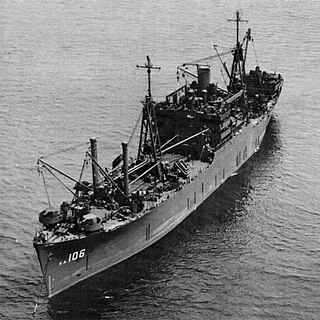
USS Union (AKA-106) was a Tolland-class attack cargo ship of the United States Navy, the fourth ship of her name. She served in World War II, the Korean War and the Vietnam War.
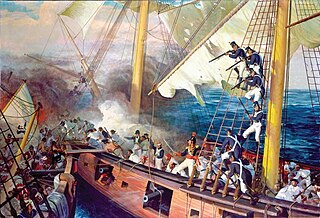
Marines, or naval infantry, are soldiers who specialise at operating in littoral zones, both on land and at sea. Historically, the main tasks undertaken by marines have included raiding ashore in support of naval objectives, and the boarding of vessels during combat or capture of prize ships. Marines also help maintain discipline and order aboard the ship. In most countries, marines are an integral part of that state's navy.

USS Ashland (LSD-1) was the lead ship of her class—the first dock landing ship of the United States Navy. She was the first Navy ship to be named for Ashland, the estate of Henry Clay, in Lexington, Kentucky.
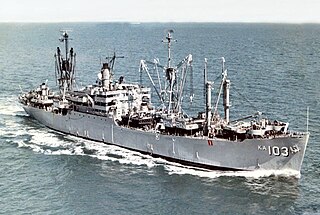
USS Rankin (AKA-103/LKA-103) was a Tolland-class attack cargo ship in service with the United States Navy from 1945 to 1947 and again from 1952 to 1971. She was finally sunk as an artificial reef in 1988.
USS York County (LST-1175) was a De Soto County-class tank landing ship built for the United States Navy during the late 1950s. The lead ship of her class of seven, she was named after counties in Maine, Nebraska, Pennsylvania, South Carolina, and Virginia, she was the only U.S. Naval vessel to bear the name.

The history of the United States Marine Corps (USMC) begins with the founding of the Continental Marines on 10 November 1775 to conduct ship-to-ship fighting, provide shipboard security and discipline enforcement, and assist in landing forces. Its mission evolved with changing military doctrine and foreign policy of the United States. Owing to the availability of Marine forces at sea, the United States Marine Corps has served in nearly every conflict in United States history. It attained prominence when its theories and practice of amphibious warfare proved prescient, and ultimately formed a cornerstone of U.S. strategy in the Pacific Theater of World War II. By the early 20th century, the Marine Corps would become one of the dominant theorists and practitioners of amphibious warfare. Its ability to rapidly respond on short notice to expeditionary crises has made and continues to make it an important tool for U.S. foreign policy.
USS Terrebonne Parish (LST-1156), originally USS LST-1156, affectionately nicknamed the "T-Bone" by her early crew, was a Terrebonne Parish-class tank landing ship built for the United States Navy in 1952. The lead ship in her class, she was named for Terrebonne Parish, Louisiana, the only U.S. Navy vessel to bear the name. The ship was later transferred to Spain and renamed Velasco (L-11), and was scrapped in 1994.

USS Barnstable County (LST-1197) was the nineteenth ship of the Newport class of tank landing ships. She was laid down on 19 December 1970 at San Diego, California, by the National Steel and Shipbuilding Corporation and launched on 2 October 1971. She was commissioned on 27 May 1972. The ship was named after Barnstable County, Massachusetts.
The United States Marine Corps's Advanced Base Force was a coastal and naval base defense force that was designed to set up mobile and fixed bases in the event of major landing operations within, and beyond, the territorial United States. Established in the beginning of the 20th century, the Advanced Base Force was the United States' first combined task force built on the concept of the Marine Corps' traditional role in expeditionary warfare. The slow development of the advanced base force played a significant role in the controversy over the removal of the ships' guards in 1908–1909.
The Fleet Landing Exercises, or FLEX were amphibious landing exercises conducted by the United States Navy and United States Marine Corps between 1935 and 1941. The purpose of these exercises was to formulate a workable amphibious warfare doctrine. The development of the necessary craft and other equipment, and the proper tactical deployment of them were also results. Finally, the exercises demonstrated the usefulness of a standing body of Marines, the Fleet Marine Force, specially prepared for amphibious expeditions.

USS Walworth County (LST-1164), previously USS LST-1164, was a United States Navy landing ship tank (LST) in commission from 1953 to 1971, and which then saw non-commissioned Military Sealift Command service as USNS Walworth County (T-LST-1164) from 1972 to 1973.

James Phillips Berkeley was an officer of the United States Marine Corps who attained the rank of lieutenant general. He is most noted as Signal Officer of 5th Marine Division during the Battle of Iwo Jima and later as commanding general of Fleet Marine Force, Atlantic. He was the son of Medal of Honor recipient, Major General Randolph C. Berkeley.
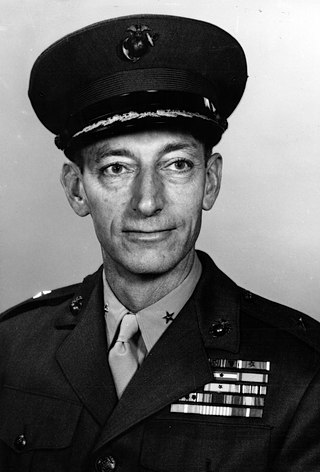
John Carroll Miller Jr. was a decorated officer in the United States Marine Corps with the rank of Brigadier general. A veteran of the Pacific War, he was wounded twice and received decorations for valor on Saipan and Okinawa. He remained in the Marines and retired as Brigadier general and Commanding general, Landing Force Training Command, Atlantic.















